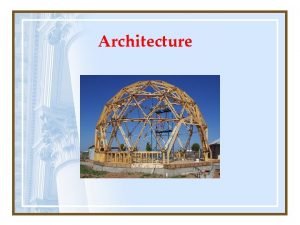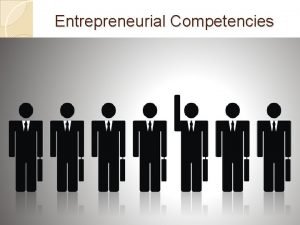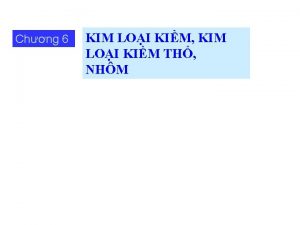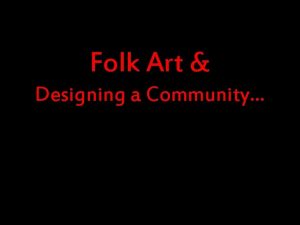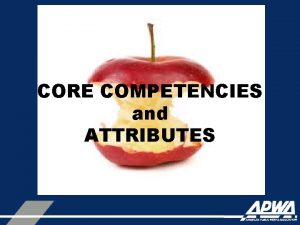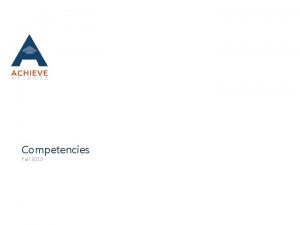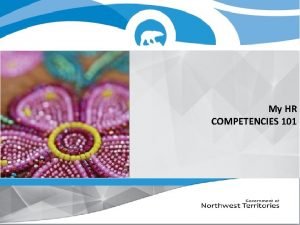The Art and Science of Designing Competencies Kim
















- Slides: 16

The Art and Science of Designing Competencies Kim Carter, Q. E. D. Foundation Chris Sturgies, Metis. Net

Q. E. D. ’s Mission is to build, inspire, cultivate and sustain cultures of transformational learning where • We are all learners with aspirations and passions which deserve to be supported in every way possible. • Learning changes lives by helping us develop the will, knowledge, skill, and capacity to achieve our aspirations. • Learning needs to happen in different ways, so we use various strengths and resources to engage with the world around us. • Learning empowers us to co-create our public world and to shape the decisions that impact our lives. 2


Competency Education • Students advance upon mastery. • Competencies include explicit, measurable, transferable learning objectives that empower students. • Assessment is meaningful and a positive learning experience for students. • Students receive timely, differentiated support based on their individual learning needs. • Learning outcomes emphasize competencies that include application and creation of knowledge, along with the development of important skills and dispositions 4

What is a Master? 5

What does it take to get really good at something?


What is Mastery? Mastery is the consistently successful application of a set of knowledge (facts), skills (processes), and behaviors (actions) to complex problems and novel situations. Students demonstrate Proficiency through a preponderance of evidence of attainment of the required competencies in and/or across a content area. Competencies are the knowledge, skills and/or behaviors students must master in a specific content or performance area. 8

What Makes a Good Competency? • Describes knowledge and skills that can be applied to novel, complex situations. • Skills will be valuable ten years from now even if the content knowledge has changed. • Learning objectives have clear performance criteria so students can identify their performance level(s) and what they need to do to improve. • Learning objectives are accompanied by effective rubrics that help students understand themselves as learners. • The competency and the learning objectives allow for personalization and opportunities for deeper learning. 9

Competency Development List characteristics of graduates (what do they need to know and be able to do? ) - e. g. effective communicator Identify how each discipline contributes to those characteristics. - e. g. English: speaking skills, organizational methods, grammar and mechanics, etc. Map the progression of knowledge and skills that get students there. - e. g. Learning progression through skill levels 10

Examples Students will make informative presentations. Students will understand that different audiences require different communication styles and strategies. Students [I can] use a wide range of strategies to communicate effectively with a variety of audiences to convey a variety of purposes. 11

Quality Competency CCSS: Adapt speech to a variety of contexts and communication tasks, demonstrating command of formal English when indicated or appropriate. MC 2: Students [I can] use a wide range of strategies to communicate effectively with a variety of audiences to convey a variety of purposes. 12

Knowledge frameworks 13

Habits 14

Habits Habit 15

Kim Carter Q. E. D. Foundation kcarter@QEDfoundation. org Chris Sturgis Metis. Net chris@metisnet. net
 The art and science of designing and constructing building
The art and science of designing and constructing building My favourite subject english
My favourite subject english Designing and delivering oral and online presentation
Designing and delivering oral and online presentation Hình ảnh bộ gõ cơ thể búng tay
Hình ảnh bộ gõ cơ thể búng tay Slidetodoc
Slidetodoc Bổ thể
Bổ thể Tỉ lệ cơ thể trẻ em
Tỉ lệ cơ thể trẻ em Chó sói
Chó sói Tư thế worm breton là gì
Tư thế worm breton là gì Chúa yêu trần thế alleluia
Chúa yêu trần thế alleluia Môn thể thao bắt đầu bằng chữ đua
Môn thể thao bắt đầu bằng chữ đua Thế nào là hệ số cao nhất
Thế nào là hệ số cao nhất Các châu lục và đại dương trên thế giới
Các châu lục và đại dương trên thế giới Công của trọng lực
Công của trọng lực Trời xanh đây là của chúng ta thể thơ
Trời xanh đây là của chúng ta thể thơ Cách giải mật thư tọa độ
Cách giải mật thư tọa độ 101012 bằng
101012 bằng
